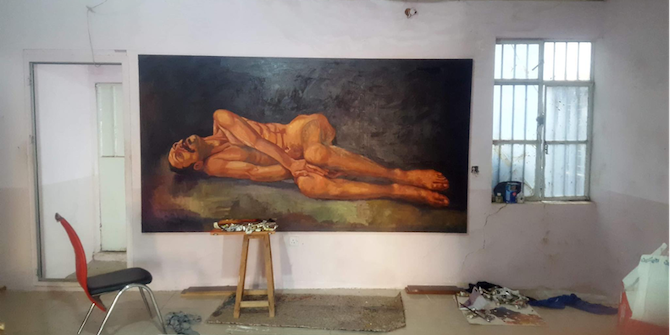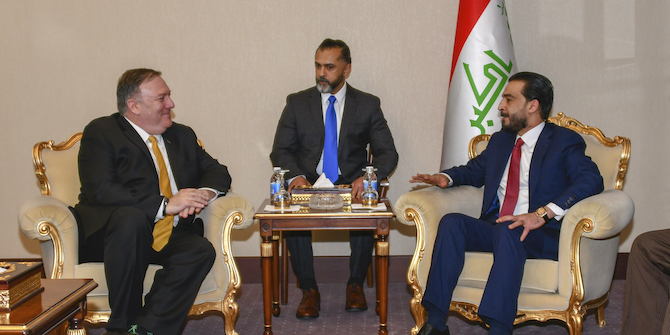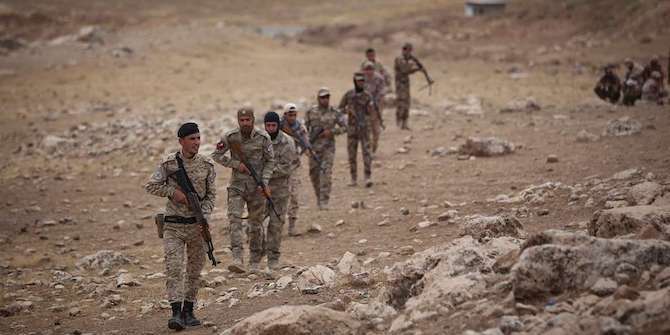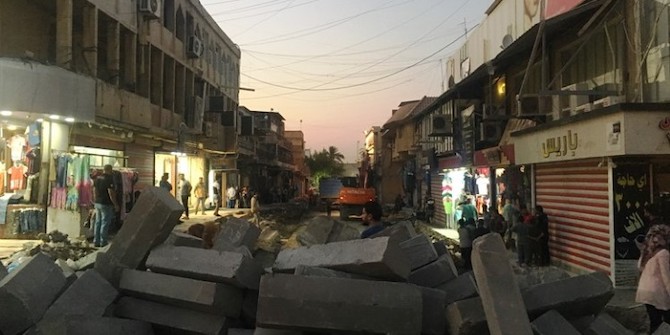by Toby Dodge
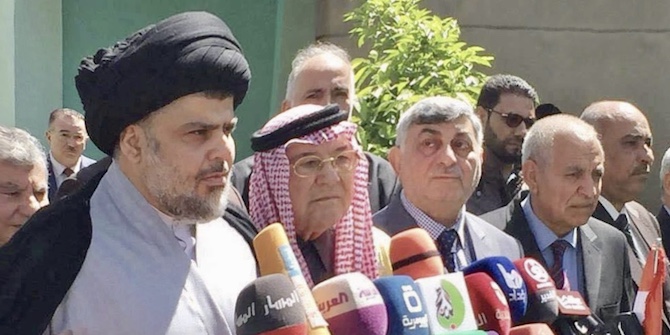
The first stage of the ruling elite’s response to Iraq’s national election results, from October 2021 to April 2022, represents the most sustained challenge to the post-2003 political system in over a decade. The initial reaction of the Iranian aligned Shi’a Islamist parties grouped in the Coordination Framework ranged from the use of violence to signal their outright rejection of the election results to their current strategy of demanding another government of national unity based on the norms of Muhasasa Ta’ifia to defend the status quo that they greatly benefit from. However, it is Muqtada al-Sadr’s attempt to maximise his election victory that poses the most sustained challenge to the current political system. In grouping together the three election winners, his own organisation, Muhammed al-Halbousi and the Kurdistan Democratic Party, he re-asserted the sectarian principles of government formation, whilst attempting to exclude two of his historical rivals for the Shi’a Islamist vote, Nuri al-Maliki and Qais al-Khazali. In asserting sectarian principles for government formation, whilst also seeking to exclude key political players, his strategy directly countered Iraqi popular opinion, which has long rejected the ethno-sectarian justification for the division of power. In using a thin electoral victory, in terms of votes secured not seats won, to try and shut out key political rivals from access to state resources, he has tried to rework the rules of the post-2003 political system in his favour.
Those most threatened by Sadr’s strategy – the election’s losers, Fateh and their allies, Haider al-Abadi’s Nasr Coalition, Ammar al-Hakim’s Hikma and Kataib Hezbollah’s Huqooq movement – were joined by Maliki’s State of Law in the Coordination Framework. Originally designed to maximise the influence of the Shi’a Islamist parties, the Coordination Framework was quickly deserted by Sadr during the election campaign. After the vote itself, it became the vehicle for the rejectionist front, those parties who had either done poorly at the ballot box or, like Fateh, did not have the strategic coherence to transform their votes into parliamentary seats and ministerial positions in any post-election government.
Different members of the Coordination Framework adopted different tactics in an attempt to minimise both their electoral defeat and Sadr’s attempt to marginalise competitors in any post-election government. Haider al-Abadi and Ammar al-Hakim were happy to use the courts to challenge the electoral result and then make Sadr’s push for a majority government as difficult as possible. Kataib Hezbollah and Asaib Ahl Al-Haq were keen to combine street protests with the deployment of their coercive capacity, to make clear the potential costs of Sadr’s attempt to exclude them.
Once the Iraqi High Electoral Commission had recounted key votes and the election results had been authenticated by the Federal Supreme Court, the Coordination Framework shifted its focus from rejection to demands for the formation of another government of national unity under the norms of Muhasasa Ta’ifia. This was seen as the best way of protecting the status quo, a status quo which would give the parties of the Coordination Framework access to state resources through their participation in government, in spite of their electoral losses.
There is evidence to indicate that at the start of the electoral campaign in July 2021, the Sadrists were not expecting to do well, as their own internal polling suggested they could win as few as 30 seats. In spite of their claims to be reformist, Sadrist forces played a key role in breaking the momentum and then suppressing the Tishreen protest movement. As the election campaign got under way, the Sadrists were also a dominant political force in a highly corrupt government that failed to deliver much needed services to its population. Ministries controlled by the Sadrists were responsible for between a third and a half of the government’s whole budget. A key Sadrist, Hamid al-Ghizzi, occupied the central role of Secretary-General in the Prime Minister’s office and the interim Prime Minister himself, Mustafa al-Kadhimi, attempted to secure support for a second term in office by further empowering Sadrists with more senior bureaucratic positions. The failure to deliver enough electricity through the summer of 2021 and a series of deadly fires in public hospitals further highlighted the Sadrist’s central role in a government failing to deliver. Sadr responded to this potential unpopularity at the ballot box, as he had before, by temporarily withdrawing his organisation from the elections in what became a successful attempt to deflect criticism, while also mobilising his core base amongst the poor urban working class.
Sadr’s political strategy gradually evolved in ambition once his organisation re-joined the electoral campaign in late August 2021. By October he had mobilised his base by demanding that the next prime minister would be a Sadrist, not just a politician aligned with the movement, in effect ruling out a second term for Mustafa al-Kadhimi. He also set out a three-year programme of government reform, that would, he claimed, tackle government corruption and restrict arms to state actors.
In his first press conference, the day after the elections themselves, it was this already ambitious agenda, an end to corruption and the abolition of the militias, that he chose to promote. It was only in November 2021 that Sadr moved to a maximalist agenda of demanding a majority government that would exclude Maliki and Khazali. This ambition came from the size of his election victory, in terms of the seats he had secured in parliament but also the ferocity of the opposition that he faced from his Shi’a Islamist rivals, especially Asaib Ahl al-Haq and Kataib Hezbollah. After the election results that he also announced the Homeland Rescue, a parliamentary alliance with the KDP and Halbousi.
From November 2021 until April 2022, Sadr was repeatedly confronted with the impossibility of his own aim of securing a majority government. The Federal Supreme Court, ruling on the need for a super majority for the election of the President, forced Sadr to open negotiations with the head of Fateh, Hadi al-Amri, with the aim of splitting the Coordination Framework and bringing some of its members into a ‘majority’ government. Finally, at the end of March 2022, after several defeats in parliament, Sadr recognised his inability to transform the rules of the system and deliver a majority government. In stepping temporarily aside and offering the Coordination Framework the chance to form a government, Sadr was counting on their inability to deliver a consensus government. His hope is that this will allow him to return to his campaign for a majority government with increased leverage. Sadr’s pause, however, gives the Coordination Framework a chance to split his coalition, bringing those with no commitment to reforming the system, Halbousi or the KDP, into another government of national unity.
It is clear that from October 2021 to April 2022, Sadr’s post-election strategy has evolved, as the extent of his victory, his ability to build an alliance with Halbousi and the KDP, and the opposition he faced from Asaib Ahl al-Haq and Kataib Hezbollah became apparent to him. The Sadrist movement has long combined a technical expertise in both mobilising its electoral base and maximising the advantage it can gain from each new electoral system. However, this has been combined with Sadr’s own unpredictable approach to Iraqi politics and the place that he and his movement occupy within it. Given the extent of the opposition he faces from within Iraq’s ruling elite to his plans for a majority government, let alone his stated aim to demobilise the country’s militias and his inability to split the Coordination Framework, a Sadrist compromise and another coalition government has always been a distinct possibility. In pushing for maximalist demands in the first six months after the elections, Sadr, in the longer run, may well have improved his bargaining power in the formation of the next coalition government, further enhancing his already dominant position within the Iraqi state.
This is Part 2 of a two-part blog series on the aftermath of the 2021 Iraqi elections. Read Part 1 here.



